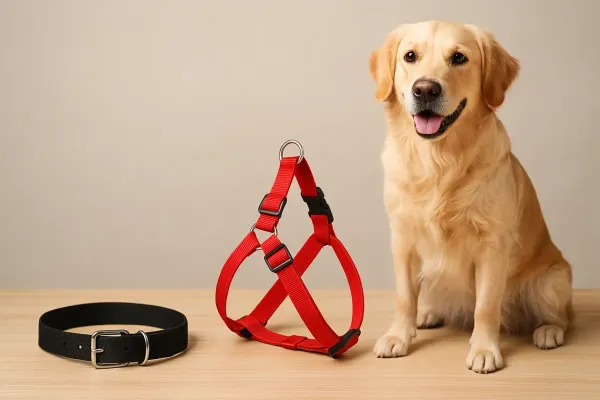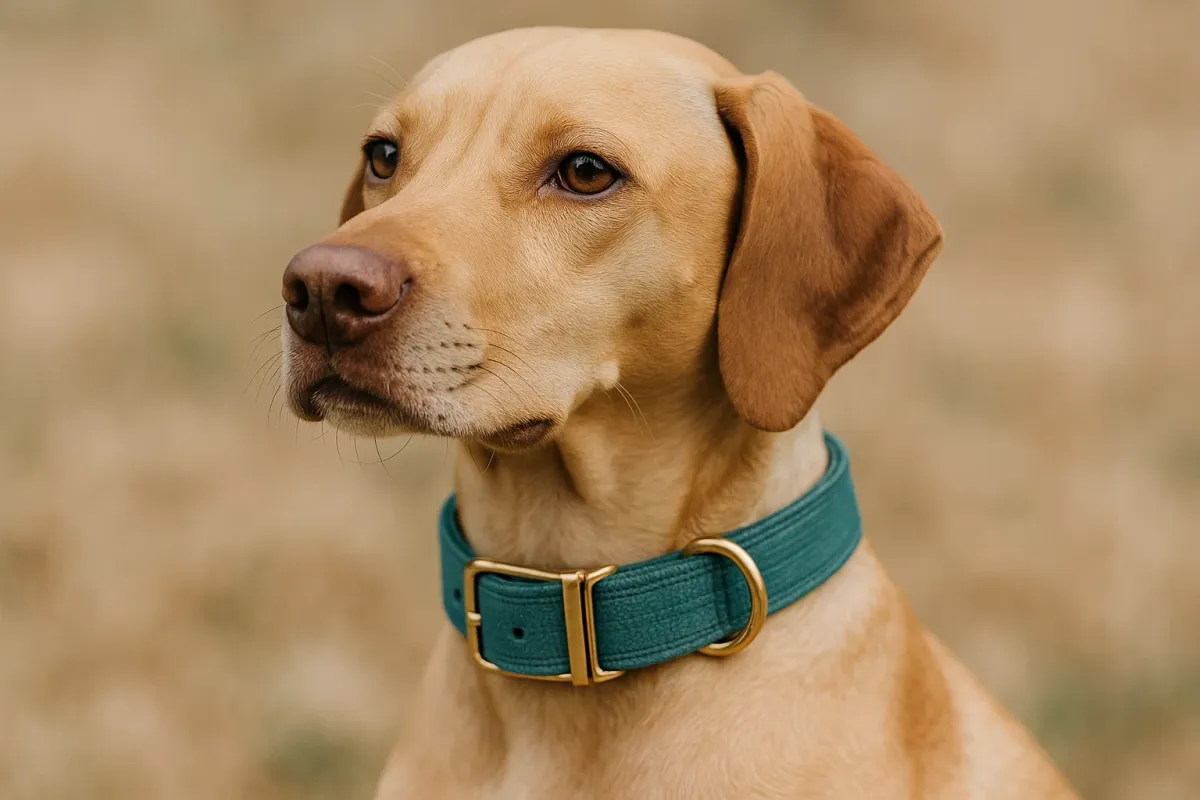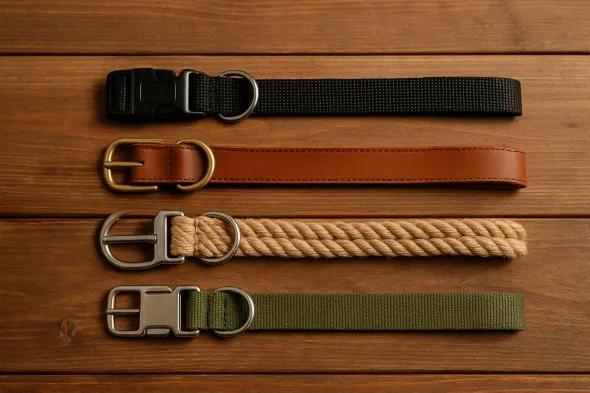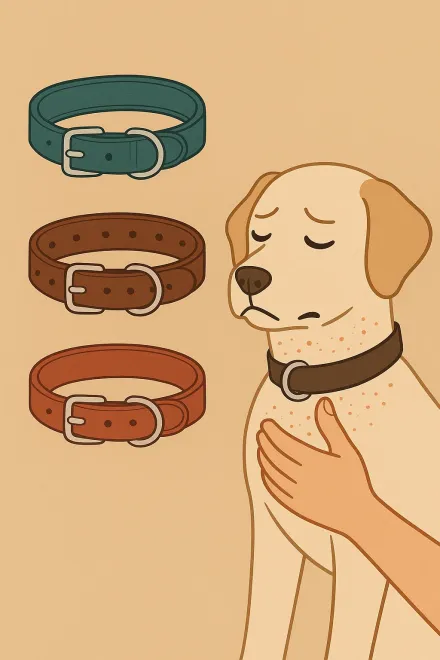
Last updated: October 15, 2025
Dog Collars for Sensitive Skin: The Ultimate Guide to Prevent Allergies and Irritations

If your dog constantly scratches its neck or develops redness after wearing a collar, it might not be a simple irritation: their skin could be sensitive or reacting allergically to certain materials.
In this article, we’ll explain how to choose the best collar for dogs with sensitive skin or allergies and which materials to avoid to keep your furry friend comfortable and protected at all times.
How to Know if the Collar Is Causing an Allergy or Irritation
Identifying an allergic reaction to the collar early is key to preventing the problem from worsening. Dogs with sensitive skin can develop irritations if the collar material isn’t suitable or if it’s worn for long periods without inspection. Paying attention to certain signs will help you act quickly and protect your pet’s health.
- Constantly scratching or biting the neck: one of the first signs of localized discomfort or itchiness around the collar area.
- Bald patches or redness: may indicate an allergic reaction or excessive friction of the material against the skin.
- Bad odor or skin discharge: trapped moisture or a secondary infection can cause an unpleasant smell around the neck.
- Scabs or small wounds: continuous irritation from the collar can lead to lesions requiring veterinary care.
If you notice any of these symptoms, remove the collar immediately and gently clean the affected area with warm water and a sterile gauze. If the irritation doesn’t improve within 24–48 hours or your dog keeps scratching, consult your trusted veterinarian. A professional exam is essential to rule out more serious allergies or skin infections.
Why Some Collars Irritate a Dog’s Skin
Allergies or irritations caused by collars are more common than many owners think. Although they often go unnoticed at first, over time they can cause significant discomfort and affect the dog’s well-being. In most cases, the issue stems from the collar materials or improper use.
Synthetic materials or chemically dyed fabrics are among the most frequent culprits. Some low-quality collars use plastic fibers or fabrics treated with harsh dyes that irritate the skin, especially in dogs with short hair or sensitive skin. Metals containing nickel or zinc — common in buckles and rings — can also trigger allergic reactions when in direct contact with the skin.
Another major factor is an incorrect collar fit. A collar that’s too tight can constantly rub against the neck, causing redness, hair loss, or even small wounds. On the other hand, if it’s too loose, it may shift and cause uneven friction. Additionally, trapped moisture after a bath or a rainy walk increases the risk of irritation, particularly if the collar isn’t properly dried.


In general, skin reactions can be avoided by choosing collars made from hypoallergenic materials and paying attention to the quality of stitching and finishes. The following materials tend to cause the most allergies:
- Low-quality nylon
- Chemically treated leather
- Non-hypoallergenic metals
Selecting products made from natural or certified hypoallergenic materials greatly reduces the risk of irritation and improves comfort, especially for dogs with delicate skin or a history of allergies.
The Best Materials for a Hypoallergenic Collar
Choosing the right collar material is essential to prevent irritation and care for your dog’s skin, especially if it’s sensitive or prone to allergies. Hypoallergenic collars made from natural or high-quality materials reduce friction, improve breathability, and ensure a softer contact with the neck.
Natural undyed leather: known for its strength, durability, and breathability. It’s ideal for medium and large dogs who need a sturdy yet comfortable collar. Keep it conditioned with natural products to maintain flexibility.
Cotton or linen: lightweight, breathable natural fibers that don’t cause allergic reactions. Perfect for small dogs or puppies, especially during warmer months. They offer a soft texture that prevents chafing.
Silicone or biothane: modern materials that are easy to clean and completely waterproof. They don’t retain moisture or dirt, making them excellent choices for active dogs or those with skin allergies. Flexible, comfortable, and durable even in humid environments.
Padded or lined neoprene: offers a cushioned feel that distributes neck pressure evenly. The best option for sporty or highly active dogs, or those with sensitive areas. Its soft inner surface prevents rubbing and improves comfort during long walks.
In summary, the best hypoallergenic collar material depends on each dog’s size, activity level, and sensitivity. Choosing natural or hypoallergenic-certified materials is the best way to ensure comfort and prevent skin reactions.

How to Choose the Best Collar for Dogs with Sensitive Skin
Selecting the right collar for a dog with sensitive skin requires attention to detail. It’s not just about the design or color, but the material, fit, and daily comfort. A poor-quality collar can cause irritation or ongoing discomfort, while a well-chosen one protects the skin and enhances overall well-being.
Here are some practical tips to make the right choice:
- Avoid unknown or very cheap materials: they often contain chemicals or plastics that can irritate the skin.
- Choose adjustable models with padded interiors: they distribute pressure better and reduce the risk of chafing.
- Pick collars without rough edges or hard seams: soft, rounded finishes prevent harsh contact with the skin.
- Check and clean the collar frequently: moisture or dirt buildup can lead to irritation or bad odors.
- Replace the collar if you notice irritation or persistent odor: these are signs of wear or an allergic reaction to the material.
A high-quality collar not only improves appearance but also supports your dog’s skin health. Investing in safe materials and checking the collar regularly is key to maintaining healthy, irritation-free skin.
Maintenance to Prevent Allergic Reactions
Proper collar maintenance is just as important as choosing the right one. Even the softest materials can cause irritation if not cleaned correctly or if left damp for too long. A good cleaning routine helps prevent allergies, odors, and bacteria buildup.
The cleaning method depends on the collar material:
- Leather: wipe with a slightly damp cloth and occasionally apply a natural cream to maintain flexibility.
- Silicone: wash with warm water and mild soap; dry thoroughly before putting it back on.
- Fabric or cotton: hand wash with gentle soap and air dry away from direct sunlight.
Avoid products containing perfume, alcohol, or solvents, as they can irritate your dog’s skin or damage the collar material. Keeping the accessory clean and dry extends its lifespan and ensures your dog stays comfortable and protected.

Mistakes to Avoid If Your Dog Has Sensitive Skin
Even when you choose a good collar, certain carelessness in its use or maintenance can worsen neck irritation and cause unnecessary discomfort. These mistakes are more common than they seem and can easily be avoided with a bit of attention. Understanding how they affect your dog’s well-being is key to keeping their skin healthy and behavior balanced.
- Not checking the collar daily: many owners forget to see if the collar has shifted, become too tight, or accumulated dirt. A quick inspection every day can help detect signs of rubbing, trapped hair, or bad odor early.
- Not drying it after a bath or rain: prolonged moisture softens the skin and encourages fungal or bacterial growth. It’s essential to dry both the collar and your dog’s neck thoroughly to prevent infections or persistent irritation.
- Using collars that are too tight: an overly snug collar prevents the skin from breathing and increases friction during movement. You should always be able to slip at least two fingers between the collar and your dog’s neck.
- Reusing old, worn-out collars: over time, materials lose flexibility, crack, or accumulate residue that can cause itching or inflammation. Replacing the collar when it shows wear is an easy way to prevent discomfort.
- Not consulting a veterinarian: if irritation doesn’t improve or wounds appear, it’s important to seek professional advice. A vet can determine whether it’s an allergic reaction, infection, or another skin condition.
Avoiding these mistakes can make the difference between an uncomfortable dog and a happy one with healthy, itch-free skin. Regularly checking, cleaning, and adjusting the collar is a simple routine that guarantees comfort, prevents skin issues, and shows responsible care for your four-legged friend’s health.
Conclusion: Well-being and Prevention for Healthy Skin
Caring for a dog with sensitive skin doesn’t have to be complicated. With the right collar and a simple maintenance routine, you can prevent irritations, itching, and allergic reactions that affect their daily comfort. The key lies in prevention and paying attention to the signs your dog gives you.
Choosing hypoallergenic materials, checking the collar frequently, and keeping it clean and dry are simple habits that make a big difference. Small actions, like adjusting the collar properly or replacing it when it’s worn out, can prevent skin issues and significantly improve your dog’s quality of life.
Ultimately, choosing wisely and staying consistent is the best way to care for your dog’s skin and comfort. A dog with a suitable, lightweight, and skin-friendly collar will not only feel better but also be happier and calmer.
Frequently Asked Questions About Dog Collars for Sensitive Skin
How can I tell if my dog is allergic to its collar?
If your dog frequently scratches its neck, has redness, hair loss, or a bad odor around the collar area, it might be experiencing an allergic reaction or skin irritation. Remove the collar immediately and observe whether the symptoms improve within a day or two.
What type of collar is best for a dog with sensitive skin?
Collars made from natural or hypoallergenic materials, such as undyed leather, cotton, linen, silicone, or biothane, are the most recommended. Avoid low-quality nylon or metals containing nickel, as they can trigger allergic reactions.
How can I clean the collar without irritating my dog’s skin?
Clean it with warm water and mild soap, and make sure it’s completely dry before putting it back on. For leather collars, use a damp cloth and natural conditioners to keep them flexible. Avoid perfumes, alcohol, or harsh detergents.
How often should I replace the collar?
It depends on the material and usage, but ideally every 6 to 12 months or sooner if it shows signs of wear, stiffness, bad odor, or cracks. A worn-out collar can irritate the skin and harbor bacteria.
Can I use a flea collar if my dog has sensitive skin?
Only if recommended by your veterinarian. Some natural flea collars are gentler and safer for dogs with sensitive skin, but chemical ones can cause irritation or allergic reactions.
What should I do if the irritation doesn’t improve?
Remove the collar and consult your veterinarian. It could be an allergic dermatitis or an infection. Avoid applying creams or home remedies without professional advice, as they could worsen the condition.


